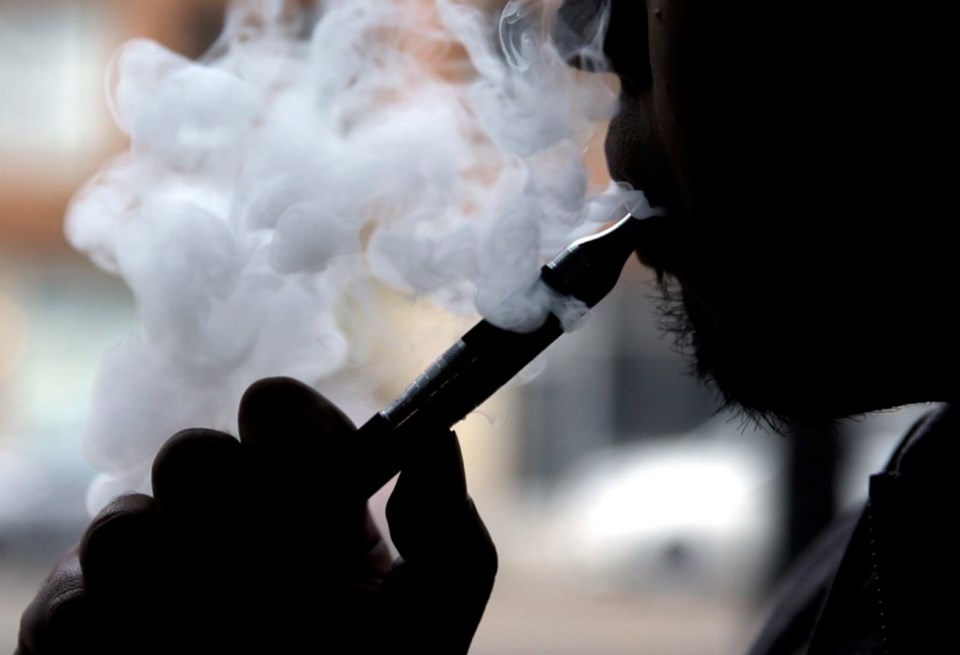Twenty years after the Capital Regional District passed Canada’s first indoor smoking bylaw, the emerging challenge is with youth vaping, says Island Health’s chief medical health officer.
“We’re really seeing a shift,” Dr. Richard Stanwick told members of the CRD’s health and housing committee Wednesday, noting that one of the biggest areas of concern is in high schools.
“We didn’t think vaping was going to take off to the extent that it has, where it’s become quite problematic within our high schools, to the point where some schools will not allow individuals to go to the washroom unaccompanied because of vaping in the washrooms.”
Stanwick said there have even been instances of students surreptitiously vaping in the classroom by hiding small vape devices up their sleeves. “The subtlety and the stealth is almost an attractive feature of these products to youths, so we’ve got some challenges ahead of us.”
The B.C. Lung Association has warned of surges in youth and young adult experimentation with vaping, which it said threatened to hook a whole new generation on nicotine.
A study on adolescent health from the Vancouver-based McCreary Centre Society found 21 per cent of all B.C. students report vaping with nicotine and 19 per cent without nicotine, based on a 2018 survey of more than 38,000 students from grades 7 to 12 in 58 school districts.
According to the latest U.S. National Youth Tobacco Survey, the number of youth who said they had used e-cigarettes in the previous 30 days was 78 per cent higher in 2018 than in 2017. Trends in Canada are believed to be similar, the Lung Association says.
Last year, at Stanwick’s recommendation, CRD directors amended the Clean Air Bylaw to put vaping and marijuana use on the same footing as tobacco.
That means vaping and pot smoking are not allowed in workplaces, parks, playgrounds, bus stops, public squares or within seven metres of doorways, windows or air intakes.
Stanwick said CRD enforcement staff regularly conduct patrols, noting the focus has always been on education.
“Instructions to staff are to go through progressive enforcement. We are not all about issuing tickets. There is no revenue return to anybody in terms of issuing those tickets.”
In 2018-19, those patrols resulted in 204 verbal warnings, 31 written warnings and three violation tickets for tobacco, 56 verbal warnings and two written warnings about vapour products, and 28 verbal warnings about cannabis.
There were 114 violation complaints and of those about 45 were substantiated, he said.
It’s not easy for staff to respond, for example, to a complaint of someone smoking at a bus stop in Colwood, Stanwick said. “We can’t get out for a single instance, but if there is someone who repeatedly is doing it at a single location, we will make efforts to address that sort of behaviour.”
Of the substantiated complaint-based violations, just under half were about people smoking within seven metres of a door, window or air intake, followed by improper or no signage and smoking within seven metres of a bus stop.
Only one was for smoking where food and beverages are served.
“So after 20 years, I would say that that’s a fairly successful compliance in terms of achieving it,” Stanwick said. “Plus, I think the public has incorporated the idea that if you go and are enjoying a beverage or food, that that occurs in a smoke-free location.”
Stanwick said it’s notable that there were zero problems with shopping malls.
“In 1997, our shopping malls went smoke-free, two years before our bylaw. So the private sector in many cases will lead and we play catch-up. We certainly played catch-up with them in terms of the vaping legislation. Both the airlines and the shopping malls went [vape-free] well before we did.”



